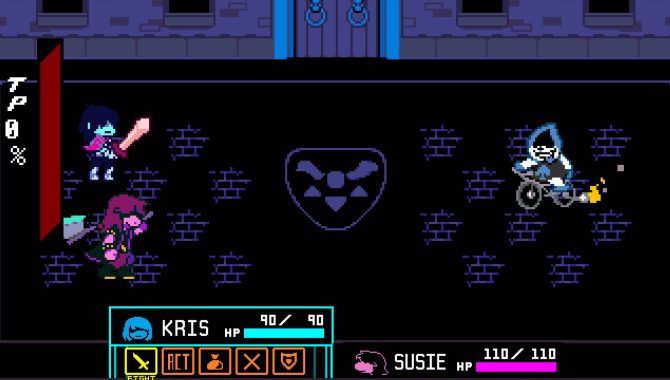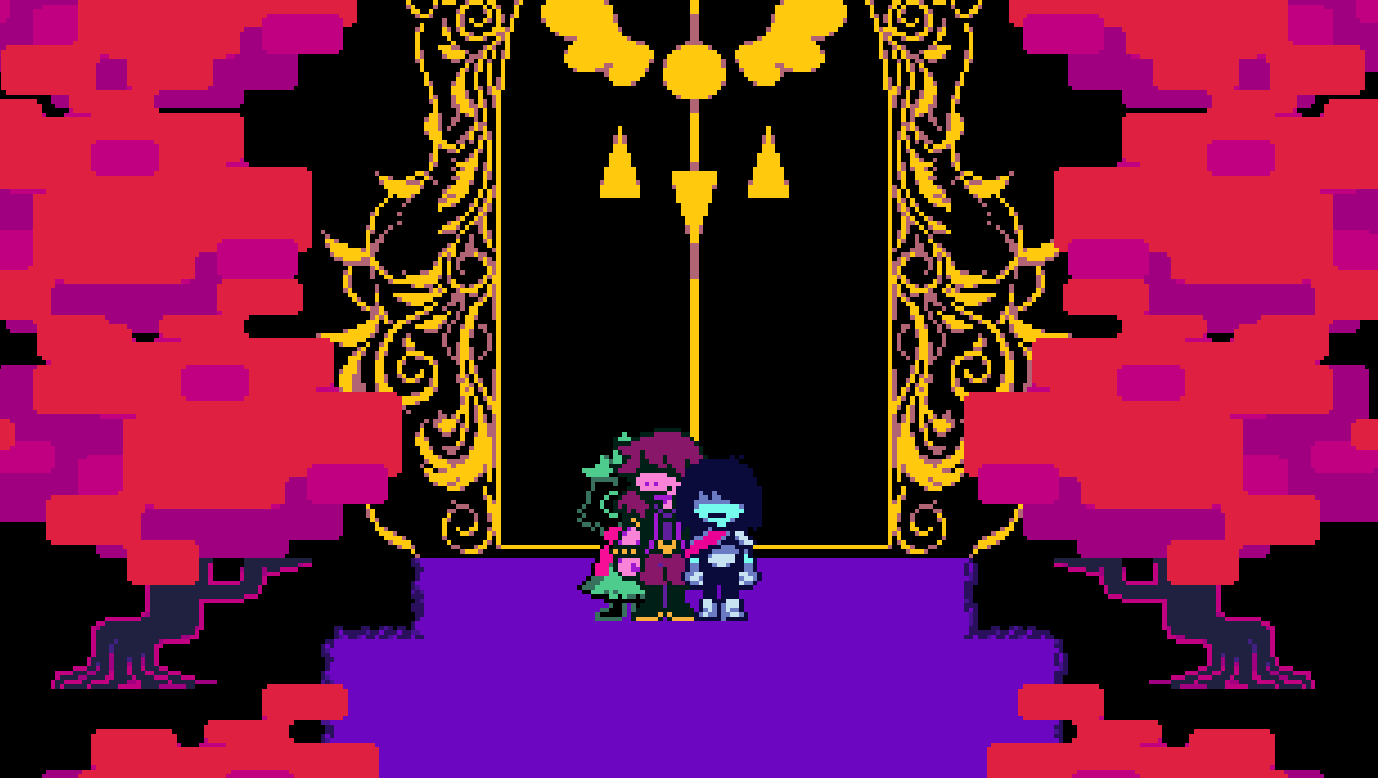Ed Note: We requested and received a review copy of The Cruel King and the Great Hero from Nippon Ichi Software.
The Cruel King and the Great Hero is a a turn based RPG by Nippon Ichi Software. It has a beautiful story book art style and the story is solid. With that said, I’m on the fence about recommending it. The mechanical aspects of its combat system sit somewhere between “Unfun” and “Rudimentary.” This isn’t helped by the game’s random encounter system, and early to mid-game world traversal.

The game starts out with Yuu, the main character, living with her father, the Dragon King, where she trains every day to become a hero. We learn fairly early on that Yuu’s actual father was a hero who traveled around defeating monsters. The details on how she ended up in the Dragon King’s care are fairly hazy, though they do get fleshed out by the end of the game. While training, the stick that she uses as a sword breaks, and the Dragon King suggests she go to the nearby monster village to get a replacement. This means traveling through the forest, which is populated by dangerous monsters that will attack her. After defeating monsters and visiting the village, she gets a new sword.
After this the game opens up a bit. I won’t go into great detail to avoid some spoilers, but the general structure is “Someone has a problem, Yuu volunteers to help them, they join as a party member, and Yuu has to go to a place to do a thing.” A majority of the game follows this structure, prior to the climax and finale.

But it does bring us to the point I want to talk about the most: the game’s combat and RPG systems. Let’s talk about the RPG systems first, because there aren’t many. You have a maximum of up to two party members at any point in time, consisting of Yuu and one other character. Prior to reaching the climax, you have no ability to choose who is in your party. The game has a level system, but there are no choices related to leveling up, or character customization.
The closest thing to customization lies in the equipment. Each character has 4 equipment slots, a weapon, an armor, and two accessories. However, I never found two weapons the game that were equivalent but with different abilities. Every new weapon was just an upgrade. The accessories are the actual customization, but even then, I used the same 4 accessories for more or less the entire game (the accessories in question were two that auto-healed each turn, one that made guarding reduce damage even further, and a stat stick that increased speed and damage). This is really the extent of character customization.
Having covered the RPG elements, let’s talk about combat. Combat is basic. You have health and energy. There are a variety of status effects, but they follow fairly standard RPG tropes. Energy is used to perform special attacks. For abilities, (if I recall correctly) prior to the final boss, Yuu had 7 skills, of which only 5 were really relevant. More on that later. These 5 could be summarized as: Heavy Attack, Fast Attack, Conditional AOE, Protect Ally, and Heavy AOE. My other party member had 4, which could be summarized as: AOE and Team Buff, Self Buff, Single Target Damage plus Status, and Heavy AOE.
Each character also has a normal attack, and a guard. The guard is the only part of the combat system I have any actual praise for, because guarding restores extra energy, making guarding vs attacking an actual meaningful choice.

The problems I have with combat are multi-layered, so let’s go through them. I mentioned above that there are conditional multi-attacks. These attacks will only hit enemies if they are lined up correctly. The problem with these attacks is that enemies never move around in combat. There is also no way to move them around. That means these attacks are only useful when enemies just happen to show up in ways that are convenient. Of the 3 potential party members, only one had access to non-conditional AOE, and so was the party member I brought with me when I could choose. Remember: you can only have one other party member.
The boss fights are the only source of real difficultly I encountered, and they don’t feel particularly fair. There were two instances of frustration I encountered. One was around the middle of the game. In that fight, the enemy used an attack that would do about 100 damage. Unfortunately, the max HP of my characters was respectively about 120 and 70. So if I ever let myself go below max, there was a non-zero chance I would get wiped by a random attack, with no telegraphing.
The other situation was the final boss fight. While I only failed it once, before returning to clear it, that first failure took around 45 minutes, and the second attempt took around 30-40. It is simply not a fun fight. Bosses are not affected by status effects, even temporarily, so the only real strategy devolved into “Make sure that they can never do an attack to kill both party members at once, and spam healing items.”
Combat just isn’t fun. Characters don’t have enough attack variety to keep things interesting, or exciting, and tactics for any encounter almost always boiled down to “Spam big AOE attacks, and hope you kill them first.” I used the word “rudimentary” in the opening paragraph, and I really mean it. The combat structure feels like it was copy-pasted from a default RPG Maker project.
All of this would be less annoying if combat wasn’t such a large portion of the game. Almost every quest and sub-quest involves traveling from point A to point B, with random encounters along the way. And while there is an item you can use to “prevent” encounters, I’m not convinced it actually works. At the very least, it doesn’t quite work as described.

Since we’re on the subject, let’s talk about traversal. Traversal is my other big gripe with the game. Yuu moves incredibly slowly. For an idea of how slowly, let me tell a story. Early on in the game, you get access to an item that lets you return to a hub zone. Later in the game while doing side quests in the ice zone, I found myself using this item often. This was because it was faster to complete an objective in the ice zone, warp back to the hub zone, walk to the teleport near the hub, and then teleport back to the ice zone, rather then just walking from one part of the ice zone to another.
But despite all this, I did finish The Cruel King and the Great Hero. I won’t lie, part of that is because I had a review copy, and I refuse to write a review of a game I can’t finish. Which is why we don’t yet have an Elden Ring review.
But the other reason is that the story is good. It’s a curious and compelling take on story book tropes. It’s not subversive, and it’s not going to win a Caldecott award or anything, but it’s generally comfy and interesting, and the story incredibly well accompanied by the art. The game’s side quests and writing all feed into this, making the end result feel like reading a set of children’s books.
Speaking of which, let’s talk about that art for bit. It’s great. I love the painterly feel, and the general soft tones. The animation is good. The UI elements are clear and crisp. The game absolutely nails a theme and feel, and that’s supported by the music. It’s just unfortunate that so much of this incredible art and comfy, if simple story, is left to carry the weight of a mediocre paint by the numbers RPG.
And those are pretty much my thoughts on The Cruel King and the Great Hero. A solid 9/10 for art, music, worldbuilding and tone. A 6/10 for passable mechanics that aren’t bad, but do nothing new, while not really offering interesting options. The game is $30 for Nintendo Switch, which honestly, seems about fair. If you want something small and comfy to play around with, and don’t mind dealing with a few aggravating moments, it might be worth picking up.





















